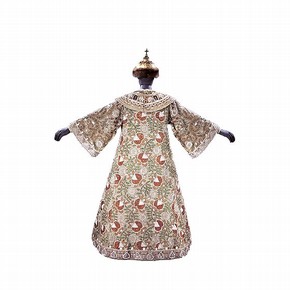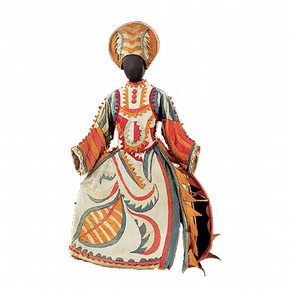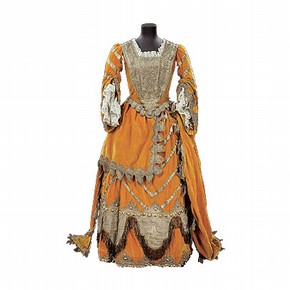Conservation Journal
Summer 2005 Issue 50
Working for Diaghilev
In December 2004, an exhibition opened at the Groninger Museum in The Netherlands called 'Working for Diaghilev' (Groningen, 11 December 2004-28 March 2005. It comprised 30 costumes from the Diaghilev Ballet and 230 paintings, drawings, set and costume designs. The State Tretyakov Gallery in Moscow lent over 100 works of art many of which were being displayed in the West for the first time. Other lenders included the Theatre Museum Bakrushin, Moscow, the Centre Pompidou in Paris, the Musée Picasso, Paris, the Musée des Arts Decoratifs, Paris, the National Gallery of Australia in Canberra and the Victoria and Albert Museum (Theatre Museum).
Groninger is a surprising museum situated in the heart of a traditional Dutch town. It was built in the 1980s with revenue from the discovery of natural gas in Northern Holland. The main building is an avant-garde structure designed by the Italian architect Alessandro Medina. Philippe Starck and the architects known as Coop Himmelb(l)au created two adjoining areas of the museum. Medina has created distinct colour combinations within the exhibition space so that the interconnecting rooms appear as a series of coloured cubes with contrasting floors, walls and ceilings, an almost perfect setting for an exhibition on Diaghilev. Facilities in the museum include a very large goods lift that opens directly into storage areas on each floor and provides easy access for packing and unpacking loan objects. The museum has a permanent collection of ceramics and costume, but its main activity is its programme of exhibitions. In recent years it has initiated important displays of Russian painting, notably 'Ilya Repin' (2001) who became part of Diaghilev's circle for a brief period in the 1890s, and the beautiful exhibition 'Russian Landscapes' which transferred to the National Gallery, London in 2004.

Figure 1: Costume for the opera Boris Godunov, Alexander Golovine, possibly dating from 1908. Museum no. S.459-1979 (click image for larger version)
The preliminary request for the loan of objects for 'Working for Diaghilev' coincided with the start of a comprehensive survey of the Diaghilev Ballet costume undertaken by Sarah Woodcock, Curator of Photography and Costume at the Theatre Museum, and myself throughout 2004. The core of the collection was acquired for the Museum through the foresight of dance critic and historian Richard Buckle, an authority on Diaghilev, when costumes first came onto the market at Sothebys in the late 1960s. In 1974 Buckle donated them to the newly-founded Theatre Museum. The collection, since added to by gift and purchase, now totals about 500 costumes and part costumes plus about 100 accessories. The purpose of the survey was to identify all priority exhibition costume and assess its conservation needs, to identify materials and initiate the analysis of metal threads and early plastics used in their construction and to assess storage needs in preparation for the proposed re-storage of the Theatre Museum collection. The results of the survey will be entered onto a database that will prepare the ground for further loans and exhibitions of this important collection. Groninger's initial request for 30 costumes resulted in the selection of 15 costumes including one of Theatre Museum's most spectacular and important objects, the costume worn by the Russian bass Feodor Chaliapin in the Coronation scene from Mussorgsky's opera 'Boris Godunov' (Figure 1).
Diaghilev's dream was to bring Russian culture to the West and create the Wagnerian ideal of 'Gesamtkunstwerken', a total work of art in which décor, costumes, music and expression were one harmonious whole. He achieved this through exhibitions and concerts but most lastingly through the ballet performances which began in 1909 and, once he established his own company, lasted until his death in 1929. Between 1909 and 1929, when the Western world was itself experiencing vast changes, Diaghilev's vision created a revolution in the theatre and had far reaching influences on the visual arts and the future of dance. Ballet in Russia had become moribund and in the West a rather dubious entertainment. Diaghilev's death in 1929 became the catalyst for the beginnings of major ballet companies in Europe and America including the Ballet Rambert, The Royal Ballet and New York City Ballet.

Figure 2: Costume for the Buffoon's wife from the ballet Chout, Mikhail Larionov, 1921. Museum no. S.762-1980 (click image for larger version)
In Russia, Diaghilev was part of the circle of artists creating the influential publication 'The World of Art', which included Alexandre Benois and Leon Bakst. It was Benois who introduced the choreographer Michel Fokine into the group and thus turned Diaghilev's interest toward the ballet. At the end of the 19th century, scenery was created by scene painters working in the prevailing style of realism. Diaghilev therefore turned to his friends within 'The World of Art' to design Fokine's ballets. The first Russian ballet season opened in the Theatre Châtélèt in Paris in 1909. The casts included the now legendary dancers Vaslav Nijinsky, Tamara Karsavina, Anna Pavlova and Adolf Bolm. Fokine's one act ballets revealed an exotic, seductive and thrilling world often perceived as shocking and revolutionary. Diaghilev's designers created explosive colour combinations that had never been seen before. His choreographers created new ways of moving, sometimes primitive and erotic with prominence given to the male dancer. Above all the Diaghilev Ballet showed that dance could express mood and emotion. Diaghilev introduced the West to Russian music and discovered and promoted both Stravinsky and Prokofiev. The success of the Diaghilev Ballet gave artists like Picasso, Gontcharova, Derain and Matisse the opportunity to realise their visions on the massive scale demanded by the design of backdrops. Diaghilev's genius lay not only in the brilliance of his vision and his enormous gifts for seeking out and promoting talent but in his eye for detail and organisation. In the years leading up to the first ballet season in Paris, he had already organised 16 exhibitions of painting including a masterly exhibition of 4000 Russian portrait painters in St Petersburg. Diaghilev supervised every detail of production, especially the lighting, in which he was an expert. He developed new choreographers, designers, composers and dancers, found patrons and funding, oversaw the organisation of the tours and the myriad routine tasks involved in running a touring company that, until the last few years of its life, had no permanent base.
The survey of the costume revealed the reality of day to day existence within the Company. There is much evidence of the stress on the costumes in performance; there are remains of make-up and theatrical repairs and some costumes still smell of sweat! The names of the dancers survive inside some costumes with second and third casts written in Russian or English. Customs stamps plot the tours of the Company. But above all, the materials and construction of the costume indicate the fluctuating fortunes of the Diaghilev Ballet which sometimes bankrupted Diaghilev's backers. The embroidery used for the creation of the Coronation robe for Chaliapin's role in 'Boris Godunov' is the work of a professional ecclesiastical workshop. The outstanding quality of the work is some indication of its cost. In contrast, the materials used for the ingenious Constructivist costumes from Chout (1921), designed by Mikhail Larionov, were made from curtain lining materials (Figure 2) as is Matisse's design for the costume of a Mourner from 'Le Chant du Rossignol' (1924) which is currently part of the Art Deco Exhibition tour.

Figure 3: Costume for Lady in Waiting, from the ballet The Sleeping Princess, Léon Bakst, 1921. Museum no. S.776-1980 (click image for larger version)
The request for the loan of the costumes to Groninger was the largest loan that Textile Conservation has ever undertaken. The work on the 'Boris Godunov' costume alone took more than 1000 hours. Initially, the costume was not considered suitable for loan because of the fragility of its surface decoration. It could not be handled or moved safely and for a number of years had been stored in the Textile Conservation Studio. The costume is decorated with facsimile pearls known as 'pearls of the Orient'. These were made from spheres of blown glass, coated on the inside with a mixture made from fish scales (often bleek or herring). The glass spheres were then filled with wax to give them some solidity.1 The weight of the costume when lying flat had crushed many of the brittle glass spheres. The ground fabric of the costume was made from a metal thread weft and a silk warp. The silk warp had disintegrated throughout the costume causing the metal thread to lift. The stitching holding many of the green and red glass beadwork had deteriorated causing the loss of many beads and the potential loss of more decoration.
Two conservators were employed to undertake the necessary work. Anne Kwaspen worked solely on the 'Boris Godunov' costume, while Anja Bayer worked on the remaining 14 costumes. The loan enabled us to have a custom made mount designed for the 'Boris Godunov' costume that will ensure its future safe storage and display.
The world of Diaghilev still captures the imagination. During the course of the survey and the conservation work for this loan, many visitors came to see the costumes. A tour of V&A patrons to the studio resulted in requests for further visits to see more material in storage. There was a visit from a large group of students involved in the Fashion Awareness Direct Graduate Fashion Competition whose theme for 2004 was 'From St Petersburg to Moscow'. The wardrobe at the Royal Opera House came to see work in progress; Sarah Woodcock advised The Royal Ballet on their revival of 'Le Spectre de la Rose' (1911) and two of the brightest principals of The Royal Ballet, Alina Cojocaru and Johan Kobburg visited Blythe House to see, among other objects, Bakst's extraordinary costumes for the 1921 production of the 'Sleeping Princess' (Figure 3).
There have been many exhibitions showing Diaghilev's artistic legacy but nothing as comprehensive as the memorable Diaghilev exhibition organised by Richard Buckle in 1954. The survey of the costume and the conservation work carried out for Groninger have made this important collection more accessible and have increased the possibilities of a major exhibition within the V&A.
Acknowledgements
I am grateful to Sarah Woodcock for reading this text and making helpful additions and adjustments.
References
1. Viegas Wesolowska K., An insight into the craftsman's techniques, 'V&A Conservation Journal' 49, (Spring 2005), p.18
Summer 2005 Issue 50
- Editorial
- Rising damp - a history of the Conservation Department
- V&A Conservation on the world wide web: a secondment to the V&A web team
- The ethics checklist - ten years on
- Plastics preservation at the V&A
- Working for Diaghilev
- Pugin's wallpapers from The Grange
- Prevention is better than the cure
- Research
- The Castellani diadem
- In pursuit of a clear answer: An Exhibition Road partnership
- Investigation of the room temperature corrosion of replica museum glass
- Professional collaboration - the Prince of Wales Museum of Western India
- V&A/RIBA partnership
- Picture and mirror frames: Reflections on treatment past, present and future
- A simple solution?
- Appendix 1: Victoria & Albert Museum Conservation Department Ethics Checklist
- Conservation of a tortoiseshell book cover
- The hand that rocks the cradle: Conservation administration, present and future
- Printer friendly version